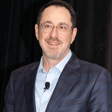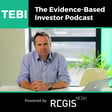Become a Creator today!Start creating today - Share your story with the world!
Start for free
00:00:00
00:00:01

Ep 38: Antti Ilmanen on investing in a low-return environment
Investors need to be realistic.. and that means accepting the strong possibility that returns will be lower in the future than they have been in the past. Why? Well, equities rose to all-time highs as the economy recovered from the Covid crisis. And the higher the price you pay for a security, the lower your expected return going forwards. So, what other evidence is there that future returns will be lower? And, if it’s true, what if anything can, or should, investors do about it? In the latest episode, Robin Powell talks to Antti Ilmanen, an investment strategist at AQR Capital Management in Greenwich, Connecticut. He’s the author of a new book, Investing Amid Low Expected Returns: Making the Most When Markets Offer the Least.
Transcript
Introduction to TEBI Podcast
00:00:07
Speaker
and welcome to the TEBI podcast from the evidence-based investor. I'm Robin Powell. This podcast is brought to you by Regis Media, which provides financial advice and planning firms with high-quality video content.
Entering an Era of Lower Investment Returns?
00:00:22
Speaker
In this episode, we're exploring the possibility that we're entering an era of lower investment returns. So, are we? And if we are, what can we do about it? Enjoy the podcast, and if you haven't already, why not subscribe to it, or better still, leave a review. We'd love to hear your views.
Balancing Optimism with Realism
00:00:50
Speaker
You need to be an optimist, to be an equity investor. You have to believe that the proceeds of capitalism will continue to reward your patience and discipline. But you also need to be realistic. And that means accepting the very strong possibility that returns will be lower in the future than they have been in the past. Why is that?
00:01:18
Speaker
Well, simply put, as of now, that's May 2022. Equity markets are trading at or near all-time highs. And the higher the price you pay for a security, the lower the expected return going forwards.
00:01:36
Speaker
So what other evidence is there that equity returns will be lower in the future? And if it's true, what, if anything, can or should investors do about it?
Interview with Ante Ilmanan
00:01:51
Speaker
I've been talking to Ante Ilmanan, an investment strategist at AQR Capital Management in Greenwich, Connecticut. He's the author of a new book called Investing Amid Low Returns,
00:02:04
Speaker
making the most when markets offer the least. It's a follow up to his first book, simply titled Expected Returns, published in 2011. I started by asking him how have his opinions changed over the last 11 years.
00:02:21
Speaker
There is a common core there. I believe largely in the same things. It's by the way, it is very evidence-based, so I am quite happy to be talking to you with your podcast. That's always been a goal.
00:02:39
Speaker
But there's been a lot of learning both from our own research, other people's research, just sort of more historical facts and another 10 years, so data.
Diversification and Timing in Investments
00:02:48
Speaker
But then I would sort of highlight maybe like one feature is that I have become even more in favor of diversification and humble about tactical timing. I think my book had, the first book had quite, I think,
00:03:04
Speaker
spirit of contrarian timing, even though I was always talking about being humble about it, but let's say I become even more humble about that. And then another thing that I must highlight is
00:03:21
Speaker
appreciating even better the importance of patience and stickiness and how hard it is in practice when we face some bad years. So it is just so human that we collectively, we expect
00:03:38
Speaker
more consistent performance than is fair or reasonable to possible to expect in a real world competitive markets. And so it's very hard for us to stick with these strategies. And so somehow that means that
00:03:56
Speaker
beliefs matter as much as evidence. Cliff sometimes says, figure out what you believe in and stick with it. I think we manage to retain our beliefs in value strategy, the most difficult reason. Drawdown, but I totally sympathize those who don't, and I suspect it will come back
00:04:17
Speaker
later when we talk how it is important for investors to think what other strategies with which they can stick with. Absolutely. So the book is no secret because I suppose it's in the title really.
The Concept of 'Investment Winter'
00:04:36
Speaker
It really focuses on how to invest in
00:04:43
Speaker
a period of lower expected returns. You use the phrase in the book, investment winter.
00:04:52
Speaker
You're not the only person, obviously, to be talking about an investment winter. I remember speaking to Elroy Dimpson a few months ago about this and he's absolutely convinced that we're going to see lower expected returns in the future. But I would ask you as a layman, how do we know? How can we be sure that we are entering a period of lower returns?
00:05:22
Speaker
Yeah, I think sure is always, I'm so sort of, I don't know, cautious that the sewer, there's never sewer. I could tell a story how we can have another 10 strong years, but it's a really difficult story to believe in, I think. So the quick answer is that the low starting yields are a very weighty answer to future long-term returns. And we really haven't had as low starting yields when you look across the board for assets.
00:05:50
Speaker
virtually ever. And this is even before I think about mean-reverting valuations. I'm just saying that from these starting yields, things will be tough. And the important thing is that this is not just for bonds. It's for, you know, every asset has its own jargon, but for equities, you can look at Shiller earnings yield. For housing, you can look at rental yields, private equity, EBITDAUER, EV, again, jargon, jargon. But
00:06:19
Speaker
But everything looks expensive compared to its own history. And those valuations, you can flip it or invert it, and that tells you the starting yield. And that is the
00:06:34
Speaker
I don't know. I think making it sure that at some horizon, this trouble will catch us. However, now the interesting and challenging question is that many of us prognosticators were highlighting these ideas 10 years ago. And since then, we have had even lower yields. And as a result, we have had quite solid returns. In particular, US equities have had this fantastic decay. And it's really, I tend to then say that you have to,
00:07:04
Speaker
Even as an equity investor, you have to learn some of the bond logic that lower required yields give you some windfall gains that boost your realized performance for a while, but they store trouble for the future. Essentially, you are borrowing returns for the future by those higher valuations. And in the last decade, S&P 500
00:07:29
Speaker
CAPE almost doubled from 20 to 40. So that's the story of why we had those high realized returns. And that's why the forecast was so wrong. For the forecast to be wrong again for next year, you would have to get
00:07:46
Speaker
even more returning and some other benign things. Maybe we can put some positive growth surprises, low inflation and so on.
Quantifying Expected Returns for 60-40 Portfolio
00:07:53
Speaker
Things that seem pretty unlikely today. So your warning of lower expected returns, can you quantify that? Can you put a figure on the sort of return that we could expect, say, I don't know, from a 60-40 portfolio going forward compared with what we've seen?
00:08:11
Speaker
Yeah, with lots of caveats, but yes. So we definitely give, and the book also gives point estimates on this, but we do like to often put some whiskers or uncertainty bands around them. I don't do that now in the book, I just do it verbally telling that.
00:08:29
Speaker
We have to be humble, even about 10-year forecasts. And again, last decade is a good case in point, how you have to do that. But so if you look at some yield-based measures, for equities, what kind of expected real return you should get, and for government bonds, this is easier. You just look at the yield minus some inflation expectations.
00:08:53
Speaker
The long-run story for a 60-40 portfolio was 4-5% real expected return, closer to 5%, actually, in the 1900s. And that was both promised and delivered in reality. And then in the last 20 years, the expected returns have been coming down, down, down, down, down. Real yields for all assets have been falling, including now 60-40 then.
00:09:16
Speaker
But that has meant that realized returns, again, have been benign. And there's, again, danger then with the rearview mirror that you look at those past returns and not the starting yields. And then with the rearview mirror, you think that, oh, everything is fine. But from starting yields, we have gone below 2%. So from that 4% or 5% expected real, we are, by some measures, we were at 1.5%.
00:09:40
Speaker
So roughly speaking, you can think sort of something close to 3% for equities and something slightly negative for government bonds. And that gives them one and a half. And obviously, that's a tough anchor for the future. So there's clearly a large element of educated guesswork about all of these questions. But one final sort of
00:10:07
Speaker
The question regarding this period of lower returns, I would ask you about, would be how long is it going to last for?
Scenarios for Different Return Outcomes
00:10:17
Speaker
I mean, after all, if say there's a crash tomorrow, I'm not suggesting for a minute there's going to be, but let's say that I don't know, markets fall 40% in a few days.
00:10:29
Speaker
and then suddenly future expected returns look pretty good again. So yeah, is this something that's going to go on for decades when we're talking about the rest of our lives, Aunty, or what? Yeah, so the part of this is
00:10:50
Speaker
Again, uncertain, uncertain, but I'd want to maybe differentiate here between short-term and long-term. Often I say this, I don't know whether the low expected returns will materialize in slow pain or fast pain. And the fast pain would be sort of the crash and then it would sort of solve, I mean, in a very painful way, it would solve the problem and so on. But I think we have such low starting yields.
00:11:14
Speaker
that I think that even if we had that crash, it probably wouldn't be so bad that it would solve the long-run problem. So let me just say that normally I am cautious about this short-term tactical timing. I already alluded to that. But it is true that stars are aligning better than I really recall with the
00:11:37
Speaker
combination of rich valuations and Fed tightening inflation problems, geopolitical problems and so on, to be bearish on equity markets in 2022. And I'm thinking a little of this kind of wily e-coyote type of situation where things really start to look bad, but markets don't quite get it and maybe gravity will come there. But so I do think that
00:12:01
Speaker
that there's vulnerability near term, but that's more, you know, sort of discretionary opinion. From my book's themes, which are very long term, I would say that it's unlikely that we'll get such a big increase. For example, the 60-40, that we would go from that one and a half percent. It has a reason to maybe, I don't know, 1.7, 1.8 now. We're still below two based on the simple metrics I use there. And then,
00:12:31
Speaker
If we get a meaningful crash, that might get us to two and a half, three, getting to four or something. I think we are talking of such ugly scenarios that we really don't want to imagine that. And then why don't I think also we don't get there
00:12:47
Speaker
If I have to pick sort of fundamental story why we are in this world, it is around this idea of savings glut, which has been like 20 years, like it could be savings glut from emerging markets, it could be from the pension savers, it can be from the wealthy who have all higher savings rates. And that is probably something that's not immediately going away. So therefore I think that
00:13:17
Speaker
It could be, if I'd have to pick, it would be a combination that sometime, sometime maybe this year or soon enough, we will get some of that fast pain and somewhat higher expected returns, but not enough to get us out of that slow pain scenario of stingy coupons and dividends still being there. And no more windfall gains that we were getting, you know, for decades, getting those repricing advantages. I think that's over and it might even be the other way around. So, you know,
00:13:47
Speaker
It's a cash center story. I'll get more positive on what we can do about it, but I think the picture is pretty bleak. Okay. Now your personal focus at AQR is on advising institutional investors.
Challenges for Institutions in Low Return Environments
00:14:03
Speaker
I'm guessing this low return environment is a real challenge for institutional investors, because as we know, a lot of pension funds around the world, certainly here in the UK are underfunded. They need to
00:14:17
Speaker
reach for higher returns, if you like, and yet the evidence shows that they're probably going to get lower returns unless they take more risk. How much of a challenge is this low return environment to institutions, and how in your experience are they responding to it?
00:14:37
Speaker
Yeah, so this is, I do think that as one exception, the corporate pension plans which have been underfunded and increasingly have had some good experiences in the last one and a half years now with yields rising and equity still doing well. So they are getting a bit better situation. So they may be running out like this is, you know, that
00:14:59
Speaker
leaving the field over defined benefits and letting employees take care of themselves. This is not a good collective answer, but this is something that conservative investors have chosen to do. Most investors have done the other thing. They have basically decided to
00:15:17
Speaker
take more risk. They recognize the challenge, most of them anyway, but they don't have what I would call, they don't have the serenity to accept the low expected returns and reduce spending plans meaningfully. Instead, they'd rather say that, okay, whatever, I want to get what I'm used to getting. I need to get 4% real or 7% nominal or whatever it is, even in this world. So let's take more risk.
00:15:45
Speaker
By the way, this kind of reaching for yield I mentioned in the book, it is a classic response, nothing new under the sun. It was done in Holland in 1750s, it was done in Britain in 1850s, it was done in US in 1950s.
00:16:01
Speaker
you know, this is like, I call this like a version of Saint Augustine's prayer. Dear Lord, let me become virtuous, but not quite yet. So they just, they want to get out of this situation by taking more risk and not get the consequences. But of course there are potential consequences. And that's sort of, that's something that does worry me. But so, and then how do they do this reaching for yield or reaching for higher returns?
00:16:32
Speaker
Some boost equities, go down the credit curve, add maybe some factor exposures. But clearly, recently, the most common approach has been to add some illiquid investments such as private equity. So, Andy, briefly, what are the most reliable evidence-based sources of long-run returns, apart from the obvious equity premium, if you like?
00:17:05
Speaker
Equity premium is the most solid. I think there are other other premiums which have got almost as good evidence, but equities will have some other advantages, you know, conventionality, embedded leverage,
00:17:23
Speaker
such a history that people will believe and theory I think is better than anything else. So I think it's understandable that
00:17:33
Speaker
that with the same evidence, there is more belief in equities. And I often say, only equities are forgiven, losing decayed. Everything else, risk sort of losing their investors with a bad decay. But the flip side is really that there are some other asset class premium again, like pretty decent.
Sources of Long-Run Returns Beyond Equity Premiums
00:17:54
Speaker
duration premium, credit premium, commodity premium when you think of asset class premium, and then this style premium, value, momentum, carry, defensive. These types of styles have had very robust evidence in many different countries, many different asset classes over 100 years, sometimes 200 years.
00:18:13
Speaker
But they do get their bad windows, and then it's a question of whether people can stick with them, and there they are no match with equities. But maybe, you know, like one cliche is that just the bad times are needed to keep the premium there, otherwise it would be arbitrage the way. I think Corey Hofstein says, no pain, no premium.
00:18:38
Speaker
Exactly. At the start of the book, you use an apple harvesting analogy with an illustration to go with it to explain what investors tend to focus on typically and what they often ignore. I found that really an effective analogy. Just talk us through that.
00:19:03
Speaker
This is a little abstract, but let me just tell you, there are apple harvesters there and the story goes that as if when seeking high expected returns, they were looking for the luschie apples at the top and they missed the low-hanging fruit. How did they miss it? Well, not very good diversification when they left all the apples in one basket.
00:19:25
Speaker
terrible risk management when they left a little girl under the ladder below one heavy apple harvester. And they had a pretty bad cost control when one person was working and one overseeing. So it's a beautiful analogy. I loved it and recommend checking it live. I do as well. So what are your thoughts on active and passive investing?
Active vs Passive Investing
00:19:53
Speaker
And in your view, does traditional active management still have a place? So I do think that traditional active managers will have some role. I think they've been always too big and were able to charge too high fees. And as a result of investors learning about sort of their
00:20:12
Speaker
collective underperformance with decent fees, we got the trend of continuing outflows, actually into barbell, into index funds, into factor funds, into private equity, into also higher costing alternatives. So I think these trends will continue and at some point there's going to be enough
00:20:42
Speaker
low-hugging fruit for traditional active managers that they can justify whatever fees that they are charging them. And I think John Bogle was sort of making a guesstimate answer. What number could it be? Is it 85% passive? That's what he and some others have thrown. But these are all guesstimates. But I do think that eventually they are going to be a minority that can justify its role for
00:21:09
Speaker
for research and price discovery purposes and also some decent active return, at least not negative ones collectively. Now AQR is obviously very closely associated with factor investing.
Factor Investing in Low Return Environments
00:21:29
Speaker
I'm guessing you will say that factor investing has a very big part to play in institutional portfolios going forward, particularly
00:21:38
Speaker
in view of this lower return environment, if you like. What's your view on factor investing? I practice what I preach or I preach what we practice. And so I definitely am a believer in them. But I'll get back to in a moment to the qualifiers. Again, I really try to be even handed always and also in this book. So I think it's
00:22:07
Speaker
I think they deserve a bigger role than they currently do. Factors or styles became quite popular in mid-2010s, but still, I think they could be more popular. But they certainly lost quite a bit of the support when there was a bad performance window, especially 2018 to 2020, mostly to value-oriented stock selection strategies, some others as well. But that was sort of at the heart of it.
00:22:33
Speaker
And so the positive story one could tell before and one can still tell and I do tell in the book is that the long run empirical story is really quite compelling for these styles, persistent over time, pervasive across countries, asset classes, robust across specifications. And so that is great, but the flip side is that any style, any investment, but also any style can suffer painfully long, bad windows.
00:23:02
Speaker
And then when those happen, any reasonable investor asks, how do I weigh between 100 years of data on paper compared to my own painful personal experience that we've lived through? And statisticians and real world investors give pretty different answers to that question then. And so my, I don't know,
00:23:27
Speaker
lesson and conclusion from this experience is that investors really should ask, well, they should educate themselves and hopefully get more patience, but really they should ask with any investments, do I have enough
00:23:45
Speaker
stickiness with this, that I can ride it through some bad years. And again, I think we all learn this over time. And I hope that some investors will take the lesson in the future that we can size certain
00:24:01
Speaker
allocations that are not too big that we leave after the classic two or three bad years, but that we can ride and we can enjoy the benefits of this long run premium. And the last thing I just say, in some sense, that was either long only or long short that I was talking about, but with the long short version, so alternative risk premia
00:24:25
Speaker
In addition, there is this exceptional diversification benefit that you are combining lots of close to zero correlated strategies and you can really get some big advantages in that portfolio construction and then some of these styles can even be
00:24:42
Speaker
very good diversifiers and even slightly negatively correlated equities perform well when equities are doing badly. Trend following and quality minus junk stock selection strategies have had those features. So I think those are, even today, those are strategies that investors should consider right now. But investors, whoever are considering this, must recognize the challenges. Unconventional, requiring leverage and shorting and lacking easy narratives
00:25:12
Speaker
not so easy to stick with us with equity. So that's my pluses and minuses. And briefly, should investors focus on a small number of factors? I'm guessing you say they should, because there are a whole zoo of factors out there. And you're saying that people should diversify across different factors as well.
00:25:42
Speaker
Yes. And so you can diversify in two nice dimensions. So one is across different factors or styles, and then you can apply them in different asset classes. So my own faith belief in these styles has certainly increased when I have learned, when we have studied the same ideas in stock selection, in country allocation, in equities, in bonds, currencies, commodities, wherever, we tend to find that the same core themes, value, momentum, carry, defensive,
00:26:09
Speaker
they tend to work in the long run, again, have their disappointing. But this gives both the dimension of diversification and it gives this sort of, I don't know, more faith at least to me that this is nothing overfitted here. So that's good. And then to your question, yes, those few styles are at the core of the things I believe.
00:26:34
Speaker
If there's a factor zoo with hundreds of things, then I think lots of it can be drank. But it's also that the hundreds may be a misleading number because that hundreds could include, I don't know, let's say 100 variants of value momentum carry defensive. And they may, to me, they may all be fine basically playing the same theme in somewhat different ways and getting mild diversification doing that.
00:27:02
Speaker
So I think there's some exaggeration when people talk about factors. But yes, my favorites are clearly in this group where I think there is increasingly a consensus that the evidence is just sort of too good to be data mined or overfitted by any means.
00:27:23
Speaker
And we're seeing a clear trend towards, as you said earlier, more expensive investments, private equity, venture capital investments, for example, particularly in the institutional investing space, also to a lesser extent in the retail space increasingly.
Trends in Private Equity and Venture Capital
00:27:43
Speaker
As you
00:27:45
Speaker
said, it's partly down to a growing realisation of the futility, if you like, of traditional active stock picking and market timing. But what are your thoughts on that? So first, I understand the attractions
00:28:05
Speaker
And I think there's some true evidence-based, not as much as for styles, because we have got much shorter histories. There is some backing to that. But really, I will emphasize that investors shouldn't expect that all the attractions come without a cost. So I'll elaborate a little on that. One thing that always irritated me was this idea that it seemed that those private assets were sort of living in a world
00:28:32
Speaker
not at all linked to the public assets with the lower expected returns and so on. Clearly they were benefiting and they were anchored by it and they were getting repriced more expensive because of the same things that were happening to bonds and stocks. But specifically I would then say that when you think of, I'll take private equity as an example, the popularity has really, it really shot up mid 2000s
00:29:00
Speaker
when David Swenson popularized the Yale model endowment model among institutional investors. And if I study historical data, and I show this in the book, the valuation gap between public and private equity narrowed quite meaningfully just around that time. And since then, we have had very narrow gap between private and public equity and slimmer outperformance than was the case earlier. So which I think makes sense. And yet,
00:29:28
Speaker
Investors, I think, have focused on this story at all. There is this long-run outperformance that you can count on. And I think it has already been coming down and probably will come down more. Related to this is that the inflows that have been getting even greater in the last couple of years, they prevent sort of the, I don't know, healthy fee pressure that might be there that we saw with hedge funds sometimes in the past. I mean, that fee pressure isn't really there, I think, with many of these private assets. It will come eventually when sort of the
00:29:57
Speaker
performance disappointments show up and that can be quite a while. So that's something. I do think that future net performance will disappoint, but anything above public assets could still be appreciated. And then there is this sort of pet peeve and Cliff also has written. So basically,
00:30:18
Speaker
illiquidity premium or discount. So there is this idea that if you lock in your money for 10 years, you should get some meaningful illiquidity premium.
00:30:30
Speaker
However, the evidence is not so clear and we do have, I think, a good counter argument that any fair illiquidity premium we should require may be offset by our collective desire for smooth returns. The lack of mark-to-market may eat up that illiquidity premium. Cliff even wonders whether it's an illiquidity discount by now.
00:30:52
Speaker
We have too little data to say either way, but again, I think logically and empirically, this sort of makes sense. Don't expect too big illiquidity premium. The last possibility is that maybe there's not too much illiquidity premium, but I will get the top managers. And there is this story, which is true that there is much more dispersion among active managers.
00:31:11
Speaker
in private assets than in public assets performance. However, it's pretty much a myth that you can more easily identify them in private equity. Maybe in venture capital, there is some of that data, but private equity buyouts not clear. So the alpha dispersion could bring you to the bottom quartile managers, just as well as to the top quartile managers.
00:31:35
Speaker
Let's be humble about that. Exactly right. Towards the end of the book, you refer to what you call bad habits on the one hand and good practices for investors on the other.
Promoting Good Investment Practices
00:31:48
Speaker
What would you say are the worst habits, if you like, that investors need to avoid? I think I'll name two. So one is this multi-year return chasing and the flip side capitulations I've already sort of talked about.
00:32:01
Speaker
that sometimes called the premier bad habits, even for experienced investors. They may know it, but it's so hard to resist. And I write in the book about this, like I try to be humble about it because it's right to be humble, but in so many ways. Anyway, so cultivating patience and consistency. There are some ways of trying to do that individually and organizationally, and I think it's
00:32:29
Speaker
It's a good quest for anybody. I think most people would agree with something I mentioned a couple of times in the book that inconsistently chasing different good strategies may end up being worse than sticking with a middling strategy.
00:32:51
Speaker
inconsistency really can be. But I think Cliff puts it very nicely, don't become a momentum investor at reversal horizons. So that's a typical three to five year horizon where you tend to get some reversals. And so that's, I think, the premier one. But in addition, I would say it's a broader thing for, I'm thinking of the younger investors today and trading oriented investors. Overconfidence is sort of the, I don't know, the mother or, actually like there is a saying, I think that pride or hubris system,
00:33:20
Speaker
father of all, all seven deadly sins. And our confidence, it's known by research to directly lead to over-trading, but it indirectly contributes to all kinds of other biases that we have, including investing. And so if I tie those together, I thought of it later that
00:33:38
Speaker
I write about them in different chapters, but then in my very last paragraphs in the book, I call for stable confidence, not worry only about overconfidence, but worry about cycles of over and under confidence. So stable confidence sort of would solve both of those challenges, is your sentence. And what about good practices? What sort of things do investors need to do to achieve better outcomes?
00:34:08
Speaker
Yeah, well, they often are, of course, flip sides of bad habits. I mean, there are some nice, so let me, so one.
00:34:16
Speaker
One was David Kabiller said 10 years ago to me that good investing results require both good investments and good investors. So I mainly talk about strategies, but I did at the end focus quite a bit on this. What's a good investor? And it's preaching about patience over return chasing, humility over overconfidence, discipline over emotions.
00:34:41
Speaker
I would add, not everybody does, but I would add probabilistic thinking over storytelling. I got this envy of storytellers. My book can't be, I don't know, Michael Lewis or many others who have got these great stories. It's mainly dealing with numbers.
00:35:01
Speaker
And that's a disadvantage in some ways, convincing people. Anyway, so I believe in aggressive diversification, which is, again, what's to do with storytelling. But then I say that, you know, like if I say harvest many different style premia, I have become more humble about that. If I can't convince somebody that this is really sustainable, long way to go, then they shouldn't follow my beliefs, you know,
00:35:30
Speaker
strategy is as good as it's only good if you can stick with it. So that's this one work we say we keep repeating and I just worth saying once more and again
00:35:45
Speaker
lessons of the last decade. Aggressive diversification. I love that phrase. Finally, Ante, you suggest in your conclusion that investors effectively face a choice in response to the low return environment
00:36:02
Speaker
Either they take more risk or they keep their risk exposure pretty much the same as it has been and inevitably settle for lower returns. Have you a preference for either of those strategies?
00:36:17
Speaker
Yeah, actually, so Jason Zweig just interviewed me for Wall Street Journal and he sort of pulled the third option there, which is the text which is sort of the contrarian timing. So I say the two extremes are taking more risk because markets now offer less and we just want to keep earning what we are used to earning. Or then there is taking less risk because nearly everything looks expensive.
00:36:42
Speaker
And you may want to wait for fatter peaches. So that's what you do. And I don't have a really strong view. I am.
00:36:51
Speaker
I like investors to consider the other side in whatever they are thinking of doing. So do whatever you do with OpenLICE. If you are going with more risk, recognize that you are doing it when valuations are exceptionally high. Or if you are relying on contrarian timing, I want to take less risk. Remember that it really has got pretty poor track record even in the long run, but certainly in the last decade it has not
00:37:22
Speaker
been helpful. So with this, you know, characteristically, I don't know, balance seeking way I have, I think the middle way appeals to me. So I think that you should consider both more risk and less risk. And if you feel strongly, go with either way, I would probably stick with the
00:37:42
Speaker
long run, normal amount of risk and try to accept serenely that in today's world that implies lower returns and lower spending than in the past when we had the tailwinds. And then, you know, the book subtitle is telling us to do things as efficiently as possible, make the most when markets offer the least. Ante Ilman, and thank you very much.
00:38:09
Speaker
And that's all from this episode of the TEBI podcast brought to you by Regis Media. Do you run an advice business? Whether it's marketing or educational content you're looking for, Regis Media can help. Just get in touch with us via the website at RegisMedia.com. That's RegisMedia.com. Until next time, from me, Robin Powell, goodbye.















